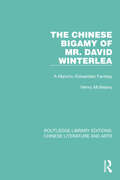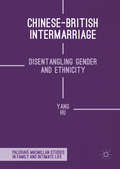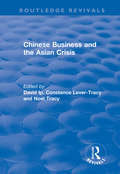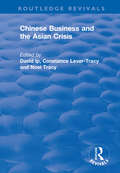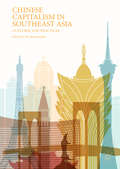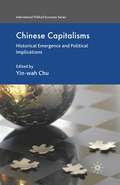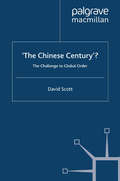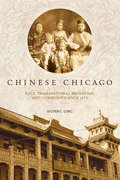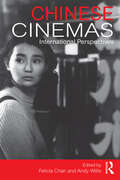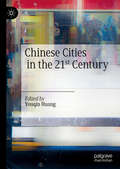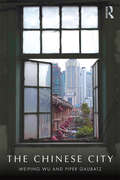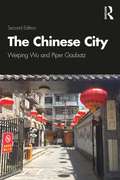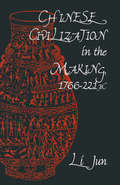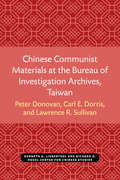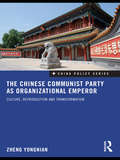- Table View
- List View
The Chinese Bigamy of Mr. David Winterlea: A Manchu-Edwardian Fantasy (Routledge Library Editions: Chinese Literature and Arts #4)
by Henry McAleavyThis book, first published in 1961, is a translation of an anonymously-written Chinese work first written in 1913 and published in Shanghai in serial form with illustrations. It is an excellent example of the popular Chinese literature featuring romances between foreigners and the Chinese, and relates the story of Mr Feng, successful merchant, and David Winterlea, English diplomat, and the sisters Lotus and Peony.
Chinese-British Intermarriage: Disentangling Gender and Ethnicity (Palgrave Macmillan Studies in Family and Intimate Life)
by Yang HuExploring how people negotiate and reconcile, construct and re-construct their distinctive gender and ethnic identities in a cross-cultural context, Hu examines what happens when two distinct cultures meet at the intimate interface of marriage and family. Chinese-British Intermarriage reveals how gender and ethnic identities intersect in distinctive ways in shaping the lived experiences of intermarried couples. Through the kaleidoscope of first-generation Chinese-British inter-ethnic families in the UK, the book brings together family, gender, migration and ethnic studies, reflecting on ongoing social processes such as individualisation and globalisation.
Chinese Business and the Asian Crisis
by David Fu-Keung Ip Constance Lever-Tracy Noel TracyThis title was first published in 2000: The Asian financial crisis and its aftermath provide a crucible in which Chinese diaspora capitalism has been tested, and a prism through which its strengths and weaknesses may be seen in a different light. The papers collected in this volume are in many ways still tentative. Some represent work-in-progress reports on as yet uncompleted research. In other cases, outcomes explored are still unclear or have not even yet fully unfolded. The aim is to focus on the consquences for diaspora Chinese capitalists and to start trying to identify losers and winners in the new landscape, re-evaluating their business culture, strategies and modes of operation, and their likely future direction and potential. The book begins by setting the scene for the Asian crisis and the achievements of the "Asian miracle". It then goes on to examine the causes of the financial crash, the firms that were able to ride the crisis, the Taiwanese economy as a whole, the fortunes of diaspora ventures in China, the small and medium enterprises at the heart of Chinese diaspora capitalism, the impact of the crisis on large Chinese business groups, and finally, the book debunks the theory that the rise of East Asia was initiated by Japan.
Chinese Business and the Asian Crisis
by David Fu-Keung Ip Constance Lever-Tracy Noel TracyThis title was first published in 2000: The Asian financial crisis and its aftermath provide a crucible in which Chinese diaspora capitalism has been tested, and a prism through which its strengths and weaknesses may be seen in a different light. The papers collected in this volume are in many ways still tentative. Some represent work-in-progress reports on as yet uncompleted research. In other cases, outcomes explored are still unclear or have not even yet fully unfolded. The aim is to focus on the consquences for diaspora Chinese capitalists and to start trying to identify losers and winners in the new landscape, re-evaluating their business culture, strategies and modes of operation, and their likely future direction and potential. The book begins by setting the scene for the Asian crisis and the achievements of the "Asian miracle". It then goes on to examine the causes of the financial crash, the firms that were able to ride the crisis, the Taiwanese economy as a whole, the fortunes of diaspora ventures in China, the small and medium enterprises at the heart of Chinese diaspora capitalism, the impact of the crisis on large Chinese business groups, and finally, the book debunks the theory that the rise of East Asia was initiated by Japan.
Chinese Business and the Asian Crisis
by David Ip Constance Lever-Tracy Noel TracyThis title was first published in 2000: The Asian financial crisis and its aftermath provide a crucible in which Chinese diaspora capitalism has been tested, and a prism through which its strengths and weaknesses may be seen in a different light. The papers collected in this volume are in many ways still tentative. Some represent work-in-progress reports on as yet uncompleted research. In other cases, outcomes explored are still unclear or have not even yet fully unfolded. The aim is to focus on the consquences for diaspora Chinese capitalists and to start trying to identify losers and winners in the new landscape, re-evaluating their business culture, strategies and modes of operation, and their likely future direction and potential. The book begins by setting the scene for the Asian crisis and the achievements of the "Asian miracle". It then goes on to examine the causes of the financial crash, the firms that were able to ride the crisis, the Taiwanese economy as a whole, the fortunes of diaspora ventures in China, the small and medium enterprises at the heart of Chinese diaspora capitalism, the impact of the crisis on large Chinese business groups, and finally, the book debunks the theory that the rise of East Asia was initiated by Japan.
Chinese Business and the Asian Crisis
by David Ip Constance Lever-Tracy Noel TracyThis title was first published in 2000: The Asian financial crisis and its aftermath provide a crucible in which Chinese diaspora capitalism has been tested, and a prism through which its strengths and weaknesses may be seen in a different light. The papers collected in this volume are in many ways still tentative. Some represent work-in-progress reports on as yet uncompleted research. In other cases, outcomes explored are still unclear or have not even yet fully unfolded. The aim is to focus on the consquences for diaspora Chinese capitalists and to start trying to identify losers and winners in the new landscape, re-evaluating their business culture, strategies and modes of operation, and their likely future direction and potential. The book begins by setting the scene for the Asian crisis and the achievements of the "Asian miracle". It then goes on to examine the causes of the financial crash, the firms that were able to ride the crisis, the Taiwanese economy as a whole, the fortunes of diaspora ventures in China, the small and medium enterprises at the heart of Chinese diaspora capitalism, the impact of the crisis on large Chinese business groups, and finally, the book debunks the theory that the rise of East Asia was initiated by Japan.
Chinese Calligraphy: An Introduction to Its Aesthetic and Technique, Third Revised and Enlarged Edition
by Yee ChiangThis is the classic introduction to Chinese calligraphy. In nine richly illustrated chapters Chang explores the aesthetics and the technique of this art in which rhythm, line, and structure are perfectly embodied. He measure the slow change from pictograph to stroke to the style and shape of written characters by the great calligraphers. It is a superb appreciation of beauty in the movement of strokes and in the patterns of structure--and an inspiration to amateurs as well as professionals interested in the decorative arts.
Chinese Calligraphy: An Introduction to Its Aesthetic and Technique, Third Revised and Enlarged Edition
by Yee ChiangThis is the classic introduction to Chinese calligraphy. In nine richly illustrated chapters Chang explores the aesthetics and the technique of this art in which rhythm, line, and structure are perfectly embodied. He measure the slow change from pictograph to stroke to the style and shape of written characters by the great calligraphers. It is a superb appreciation of beauty in the movement of strokes and in the patterns of structure--and an inspiration to amateurs as well as professionals interested in the decorative arts.
Chinese Capitalism in Southeast Asia: Cultures and Practices
by Yos SantasombatThis collection examines the historically and geographically specific form of economic organization of the overseas Chinese in Southeast Asia and how it has adapted to the different historical and socio-political contexts of Southeast Asian countries. Moving beyond cultural explanations and traits to focus on the process of evolution and dynamism of situated practices, it argues that Chinese Capitalism is rapidly becoming a form of ‘hybrid capitalism’ and embodies the interdependent of culturally and institutionally specific dynamics at local and regional level, evolving and adapting to different institutional contexts and politico-economic conditions in the host Asian economies. This text also explores the social organization and political economy of the so-called overseas Chinese by examining the changing dynamism of Chinese capitalism in relation to forces of globalization. Focusing on key actors, primarily Chinese entrepreneurs in their business practices, and situated practices as well as cultural, political, social and economic factors under globalizing conditions, it provides providing a broad understanding without fixating or homogenizing Chinese capitalism, contributing to the understanding of the contexts that give rise to the emergence and transformation of Chinese Capitalism in Southeast Asia.
Chinese Capitalism in Southeast Asia: Cultures and Practices
by Yos SantasombatThis collection examines the historically and geographically specific form of economic organization of the overseas Chinese in Southeast Asia and how it has adapted to the different historical and socio-political contexts of Southeast Asian countries. Moving beyond cultural explanations and traits to focus on the process of evolution and dynamism of situated practices, it argues that Chinese Capitalism is rapidly becoming a form of ‘hybrid capitalism’ and embodies the interdependent of culturally and institutionally specific dynamics at local and regional level, evolving and adapting to different institutional contexts and politico-economic conditions in the host Asian economies. This text also explores the social organization and political economy of the so-called overseas Chinese by examining the changing dynamism of Chinese capitalism in relation to forces of globalization. Focusing on key actors, primarily Chinese entrepreneurs in their business practices, and situated practices as well as cultural, political, social and economic factors under globalizing conditions, it provides providing a broad understanding without fixating or homogenizing Chinese capitalism, contributing to the understanding of the contexts that give rise to the emergence and transformation of Chinese Capitalism in Southeast Asia.
Chinese Capitalism in Southeast Asia: Cultures and Practices
by Yos SantasombatThis collection examines the historically and geographically specific form of economic organization of the overseas Chinese in Southeast Asia and how it has adapted to the different historical and socio-political contexts of Southeast Asian countries. Moving beyond cultural explanations and traits to focus on the process of evolution and dynamism of situated practices, it argues that Chinese Capitalism is rapidly becoming a form of ‘hybrid capitalism’ and embodies the interdependent of culturally and institutionally specific dynamics at local and regional level, evolving and adapting to different institutional contexts and politico-economic conditions in the host Asian economies. This text also explores the social organization and political economy of the so-called overseas Chinese by examining the changing dynamism of Chinese capitalism in relation to forces of globalization. Focusing on key actors, primarily Chinese entrepreneurs in their business practices, and situated practices as well as cultural, political, social and economic factors under globalizing conditions, it provides providing a broad understanding without fixating or homogenizing Chinese capitalism, contributing to the understanding of the contexts that give rise to the emergence and transformation of Chinese Capitalism in Southeast Asia.
Chinese Capitalisms: Historical Emergence and Political Implications (International Political Economy Series)
by Y. ChuIn Chinese Capitalisms , experts examine the rise of capitalism on China and Taiwan, analyzing impacts exerted by global capitalism, Chinese civilization, and remnants of socialist practice. In focusing on these, they also address longstanding issues such as Weber's China Thesis, state-business relationships, and China's civil society, among others.
'The Chinese Century'?: The Challenge to Global Order (Global Issues)
by D. ScottThis book looks ahead to consider the most likely results of the encounter between China and the international system. Environmental, cultural and perceptual matters are considered as well as more traditional economic and military issues. Underpinning the book is the question will the 21st century be 'China's Century', for China and the world?
Chinese Chicago: Race, Transnational Migration, and Community Since 1870 (Asian America #74)
by Huping LingNumerous studies have documented the transnational experiences and local activities of Chinese immigrants in California and New York in the late nineteenth and early twentieth centuries. Less is known about the vibrant Chinese American community that developed at the same time in Chicago. In this sweeping account, Huping Ling offers the first comprehensive history of Chinese in Chicago, beginning with the arrival of the pioneering Moy brothers in the 1870s and continuing to the present. Ling focuses on how race, transnational migration, and community have defined Chinese in Chicago. Drawing upon archival documents in English and Chinese, she charts how Chinese made a place for themselves among the multiethnic neighborhoods of Chicago, cultivating friendships with local authorities and consciously avoiding racial conflicts. Ling takes readers through the decades, exploring evolving family structures and relationships, the development of community organizations, and the operation of transnational businesses. She pays particular attention to the influential role of Chinese in Chicago's academic and intellectual communities and to the complex and conflicting relationships among today's more dispersed Chinese Americans in Chicago.
Chinese Cinemas: International Perspectives
by Felicia Chan Andy WillisChinese Cinemas: International Perspectives examines the impact the rapid expansion of Chinese filmmaking in mainland China has had on independent and popular Chinese cinemas both in and outside of China. While the large Chinese markets are coveted by Hollywood, the commercial film industry within the People’s Republic of China has undergone rapid expansion since the 1990s. Its own production, distribution and exhibition capacities have increased exponentially in the past 20 years, producing box-office success both domestically and abroad. This volume gathers the work of a range of established scholars and newer voices on Chinese cinemas to address questions that interrogate both Chinese films and the place and space of Chinese cinemas within the contemporary global film industries, including the impact on independent filmmaking both within and outside of China; the place of Chinese cinemas produced outside of China; and the significance of new internal and external distribution and exhibition patterns on recent conceptions of Chinese cinemas. This is an ideal book for students and researchers interested in Chinese and Asian Cinema, as well as for students studying topics such as World Cinema and Asian Studies.
Chinese Cinemas: International Perspectives
by Felicia Chan Andy WillisChinese Cinemas: International Perspectives examines the impact the rapid expansion of Chinese filmmaking in mainland China has had on independent and popular Chinese cinemas both in and outside of China. While the large Chinese markets are coveted by Hollywood, the commercial film industry within the People’s Republic of China has undergone rapid expansion since the 1990s. Its own production, distribution and exhibition capacities have increased exponentially in the past 20 years, producing box-office success both domestically and abroad. This volume gathers the work of a range of established scholars and newer voices on Chinese cinemas to address questions that interrogate both Chinese films and the place and space of Chinese cinemas within the contemporary global film industries, including the impact on independent filmmaking both within and outside of China; the place of Chinese cinemas produced outside of China; and the significance of new internal and external distribution and exhibition patterns on recent conceptions of Chinese cinemas. This is an ideal book for students and researchers interested in Chinese and Asian Cinema, as well as for students studying topics such as World Cinema and Asian Studies.
Chinese Cities in the 21st Century
by Youqin HuangThis book is an interdisciplinary examination of China's new urban development model and the challenges Chinese cities face in the 21st century. China is in the midst of a historic developmental inflection point, grappling with a significantly slowing economy, rapidly rising inequality, massive migration, skyrocketing housing prices, alarming environmental problems, and strong pushback from the West. In this volume, Western and Chinese scholars in different disciplines offer the clearest look yet at some of the main challenges China faces, including domestic and international contexts, the new urban development model, inclusion and well-being of migrants and their families, and urban sustainability. This book sheds light on China’s ongoing development and future directions, and has strong policy implications for anyone interested in the future of China.
The Chinese City
by Weiping Wu Piper GaubatzChina’s cities are home to 10 percent of the world’s population today. They display unprecedented dynamism under the country’s surging economic power. Their remarkable transformation builds on immense traditions, having lived through feudal dynasties, semicolonialism, and socialist commands. Studying them offers a lens into both the complex character of the changing city and the Chinese economy, society, and environment. This text is anchored in the spatial sciences to offer a comprehensive survey of the evolving urban landscape in China. It is divided into four parts, with 13 chapters that can be read together or as stand-alone material. Part I sets the context, describing the geographical setting, China’s historical urban system, and traditional urban forms. Part II covers the urban system since 1949, the rural–urban divide and migration, and interactions with the global economy. Part III outlines the specific sectors of urban development, including economic restructuring, social–spatial transformation, urban infrastructure, and urban land and housing. Finally, part IV showcases urbanism through the lens of the urban environment, lifestyle and social change, and urban governance. The Chinese City offers a critical understanding of China’s urbanization,exploring how the complexity of the Chinese city both conforms to and defies conventional urban theories and experience of cities elsewhere around the world. This comprehensive book contains a wealth of up-to-date statistical information, case studies, and suggested further reading to demonstrate the diversity of urban life in China.
The Chinese City
by Weiping Wu Piper GaubatzChina’s cities are home to 10 percent of the world’s population today. They display unprecedented dynamism under the country’s surging economic power. Their remarkable transformation builds on immense traditions, having lived through feudal dynasties, semicolonialism, and socialist commands. Studying them offers a lens into both the complex character of the changing city and the Chinese economy, society, and environment. This text is anchored in the spatial sciences to offer a comprehensive survey of the evolving urban landscape in China. It is divided into four parts, with 13 chapters that can be read together or as stand-alone material. Part I sets the context, describing the geographical setting, China’s historical urban system, and traditional urban forms. Part II covers the urban system since 1949, the rural–urban divide and migration, and interactions with the global economy. Part III outlines the specific sectors of urban development, including economic restructuring, social–spatial transformation, urban infrastructure, and urban land and housing. Finally, part IV showcases urbanism through the lens of the urban environment, lifestyle and social change, and urban governance. The Chinese City offers a critical understanding of China’s urbanization,exploring how the complexity of the Chinese city both conforms to and defies conventional urban theories and experience of cities elsewhere around the world. This comprehensive book contains a wealth of up-to-date statistical information, case studies, and suggested further reading to demonstrate the diversity of urban life in China.
The Chinese City
by Weiping Wu Piper GaubatzDrawing on years of research experience and keen observations of the triumphs and problems in China’s cities, the authors provide a foundational understanding of China’s urbanization and cities that is grounded in history and geography and challenges readers to consider Chinese urbanization through multiple disciplinary and thematic lenses. This book is anchored in the spatial sciences, including geography, urban studies, urban planning, and environmental studies. It offers a comprehensive survey of the evolving urban landscape, covering such topics as history and patterns of urbanization, spatial and regional context, models of urban form, economic and social-spatial transformation, urbanism and cultural dynamics, housing and land development, environmental and infrastructure issues, poverty and inequality, and challenges of urban governance. The book highlights both parallels and substantive differences between China and comparable cities and countries elsewhere, given that some urban conditions around the world converge and point to shared catalysts (e.g. internal migration) and globally linked processes (e.g. climate change). It explores the consequences of the demographic, economic, social, and environmental transitions on cities and urban dwellers. Illustrated case studies in each chapter ground the discussion and introduce readers to the diversity of cities and urban life in China. Most chapters also can be used as stand-alone course materials, with suggested references for further reading. Intended for a wide audience in higher education and beyond, this book will be useful to readers interested in Chinese Studies, East Asian Studies, Urban Studies, Urban Geography, or Urban Planning.
The Chinese City (A\world Bank Publication)
by Weiping Wu Piper GaubatzDrawing on years of research experience and keen observations of the triumphs and problems in China’s cities, the authors provide a foundational understanding of China’s urbanization and cities that is grounded in history and geography and challenges readers to consider Chinese urbanization through multiple disciplinary and thematic lenses. This book is anchored in the spatial sciences, including geography, urban studies, urban planning, and environmental studies. It offers a comprehensive survey of the evolving urban landscape, covering such topics as history and patterns of urbanization, spatial and regional context, models of urban form, economic and social-spatial transformation, urbanism and cultural dynamics, housing and land development, environmental and infrastructure issues, poverty and inequality, and challenges of urban governance. The book highlights both parallels and substantive differences between China and comparable cities and countries elsewhere, given that some urban conditions around the world converge and point to shared catalysts (e.g. internal migration) and globally linked processes (e.g. climate change). It explores the consequences of the demographic, economic, social, and environmental transitions on cities and urban dwellers. Illustrated case studies in each chapter ground the discussion and introduce readers to the diversity of cities and urban life in China. Most chapters also can be used as stand-alone course materials, with suggested references for further reading. Intended for a wide audience in higher education and beyond, this book will be useful to readers interested in Chinese Studies, East Asian Studies, Urban Studies, Urban Geography, or Urban Planning.
Chinese Civilization in the Making, 1766–221 BC
by Jun LiThis book provides a fresh interpretation of how Chinese civilization was created and transformed in the process of its early formation (1766-221 BC). It describes the principal features of that civilization which had a profound impact on the later development of Chinese history. In particular, it discusses in detail the main characteristics of the social and political organizations of that period, and argues that, contrary to the traditional interpretation, economic development in ancient China had its own dynamism.
Chinese Communist Materials at the Bureau of Investigation Archives, Taiwan (Michigan Monographs In Chinese Studies #24)
by Peter Donovan Carl E. Dorris Lawrence R. SullivanDuring the long years of civil strife in China the Nationalist authorities amassed extensive materials on their Communist adversaries. Now stored in government institutions on Taiwan, these materials are an excellent source for the study of the Chinese Communist movement. Among them is the Bureau of Investigation Collection (BIC), which holds over 300,000 volumes of primary documents on the Chinese Communist movement. The purpose of Chinese Communist Materials is, without any attempt at comprehensive listing of the Bureau’s holdings, to give scholars a representative description of the collection, to point out its implications for research, and suggest new areas for research at the Bureau in the fields of political science and history [1, 4].
The Chinese Communist Party as Organizational Emperor: Culture, reproduction, and transformation (China Policy Series)
by Zheng YongnianThe Chinese Communist Party (CCP) is the largest and one of the most powerful, political organizations in the world today, which has played a crucial role in initiating most of the major reforms of the past three decades in China. China’s rapid rise has enabled the CCP to extend its influence throughout the globe, but the West remains uncertain whether the CCP will survive China’s ongoing socio-economic transformation and become a democratic country. With rapid socio-economic transformation, the CCP has itself experienced drastic changes. Zheng Yongnian argues that whilst the concept of political party in China was imported, the CCP is a Chinese cultural product: it is an entirely different breed of political party from those in the West - an organizational emperor, wielding its power in a similar way to Chinese emperors of the past. Using social and political theory, this book examines the CCP’s transformation in the reform era, and how it is now struggling to maintain the continuing domination of its imperial power. The author argues that the CCP has managed these changes as a proactive player throughout, and that the nature of the CCP implies that as long as the party is transforming itself in accordance to socio-economic changes, the structure of party dominion over the state and society will not be allowed to change.
